This young Vervet monkey is part of a group enjoying early morning winter sunshine while eating berries from the Pigeonwood (Trema orientalis) tree. I like how the youngster is taking advantage of a wild banana (Strelizia nicolai) leaf as a partial hammock.
Most weeks it turns out that something to post about on naturebackin presents itself, even if just in the nick of time. But this week when looking through photos taken in the garden this year, I thought I would pick out a few photos taken during autumn and winter to make a change from exploring a single topic.
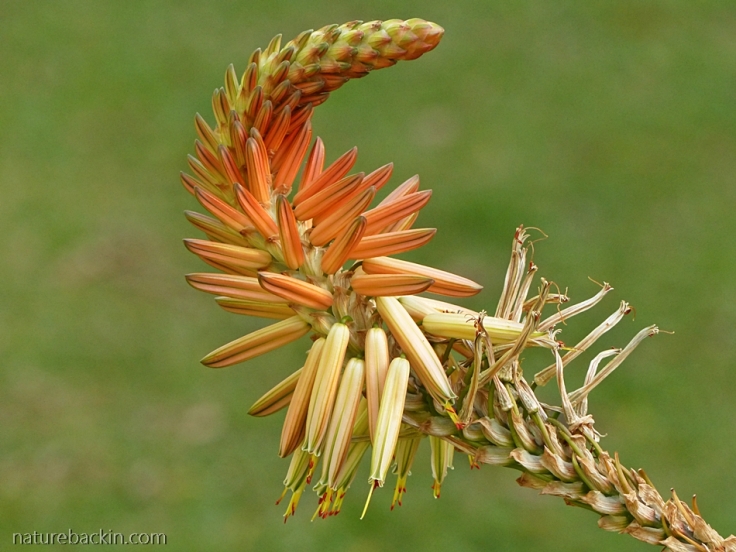
One of the winter-flowering aloes. The flower head is long lasting and provides nectar and pollen to insects and birds. The flowers at the lower end are starting to go to seed. This plant has one flower stem and inflorescence only. I thought I’d kept a note of its name – but it seems I didn’t!

Aloe leaves and thorns are there to be photographed all year round. These are leaves and a dry flower stem of the summer flowering Aloe cooperi
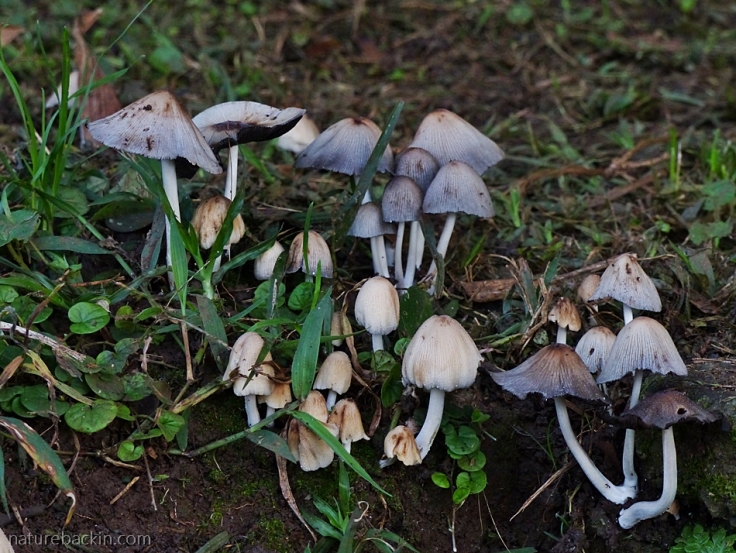
Photographed in May when the last rains of the season fell, these small mushrooms, which sprout for only a few days, are fed by a decaying tree root. We have had no rain at all during June and July and unusually high temperatures this winter, so now there are no mushrooms to be seen and any bract fungi that are still evident are desiccated
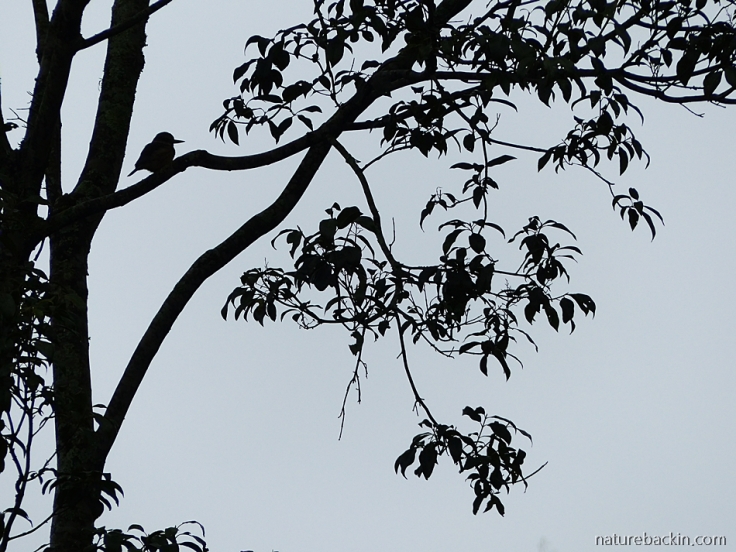
A perching Brownhooded Kingfisher and graceful tree branch in silhouette. I think that this photo looks vaguely Japanese in character though I can’t say why. The Brownhooded Kingfisher is conspicuous in the garden all year round. For a previous post featuring this kingfisher catching crickets see here

Distasteful to most birds, this is an acraea butterfly in its larval/caterpillar stage

A photograph of a pupa of the same butterfly, most likely the Blood-red Acraea. The pupa was very exposed on a leaf of a shrub neighbouring the African Dog Rose, which is the larval host plant of this butterfly. I went to check on it most days hoping to see the butterfly emerging when the time was right. But one morning all I found was a short stump still attached to the leaf. The rest had evidently been snapped off and eaten, most likely by a visiting cuckoo
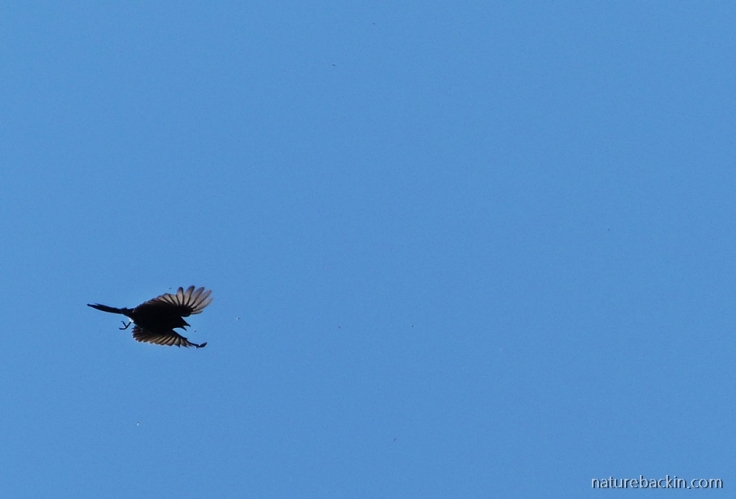
And here is a rather quirky shot of a Fork-tailed Drongo catching insects on the wing. It is too far away for detail, but I like the timing and the outstretched foot as the bird zones in to snap up an insect

I seldom see ants as large as this one in our garden. I would guess that this one is between 5 and 10 mm in length. It is a handsome long-legged ant. Perhaps it is one of the formicine ants?

A honey bee seeking food at a Bird of Paradise (Strelizia reginae), which flowers well into the winter months
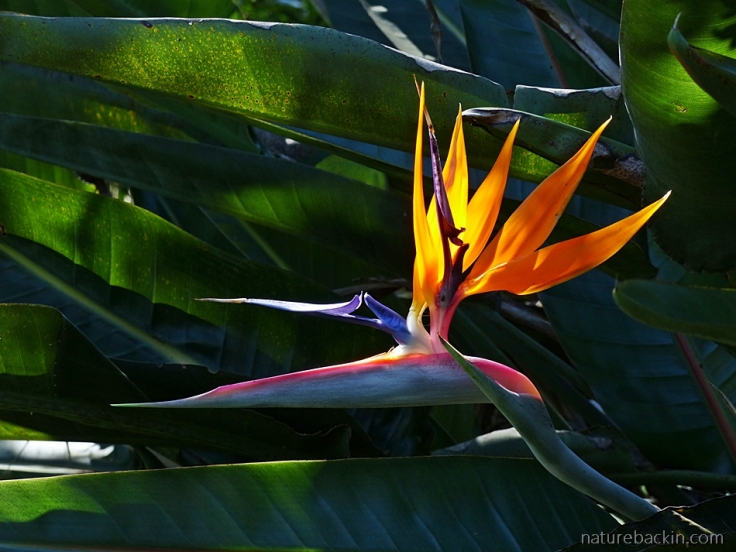
A Bird of Paradise glowing in the winter sunshine
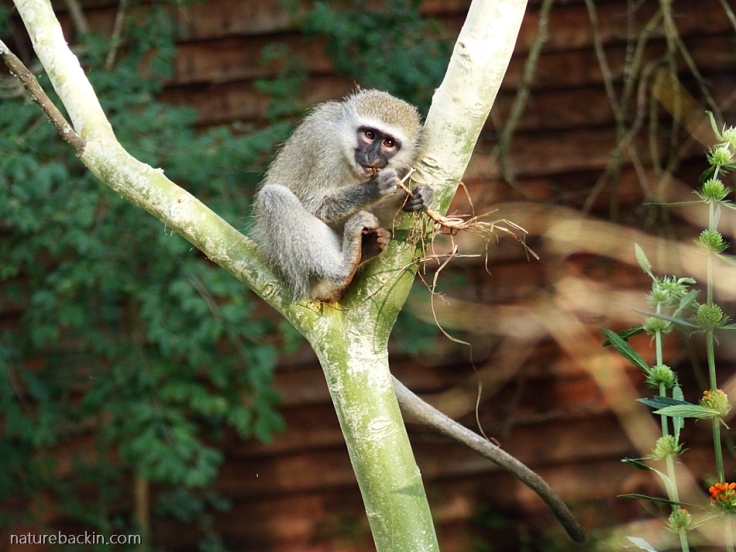
The dry months of winter can make subsistence hard for many creatures, including Vervet monkeys. Sitting in the crook of a small Fever Tree, this young monkey eats the roots of grasses that I had dug out of a flowerbed a few days before
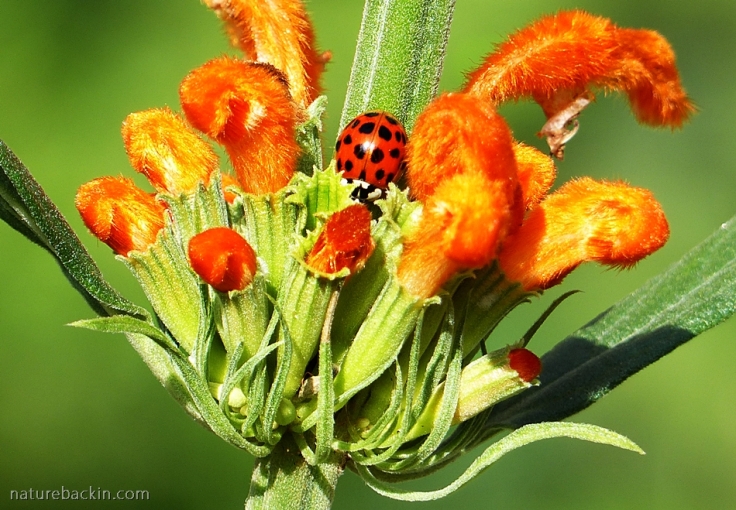
A ladybird visiting a Wild Dagga (Leonotis leonurus) plant, which also flowers well from autumn into the months of winter
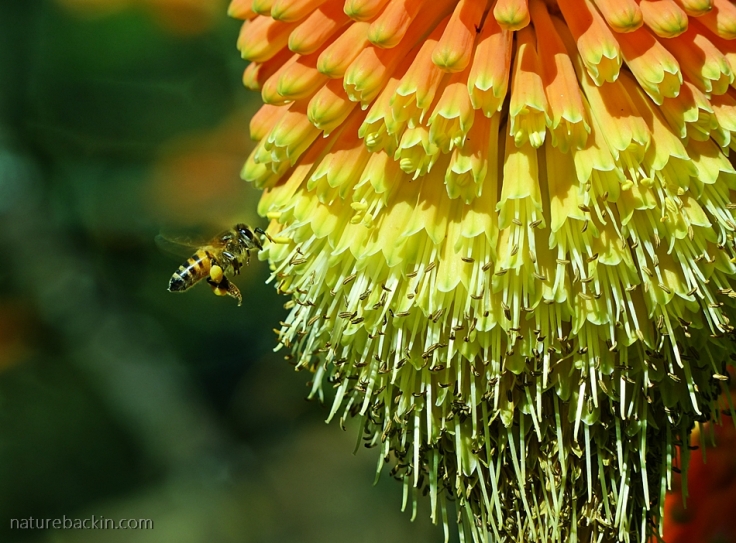
Another autumn-into-winter flowering plant is this Red Hot Poker (Kniphofia praecox). It is a definite favourite with honeybees
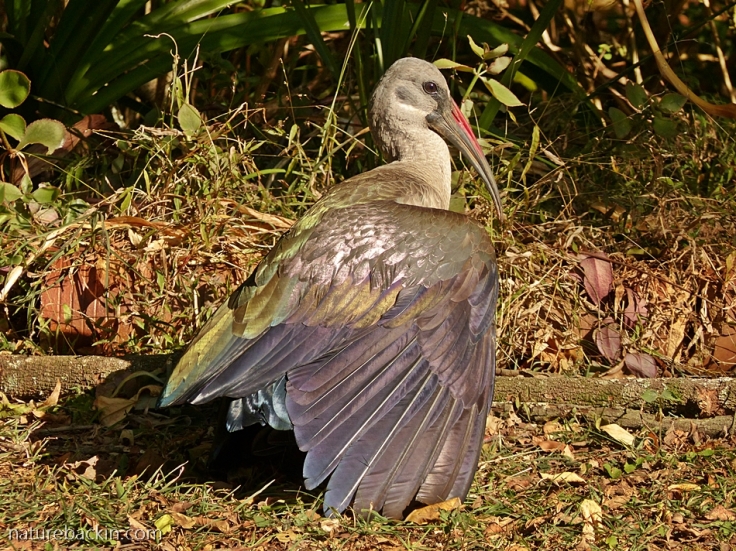
A Hadeda Ibis sunbathing in the winter sunshine shows off the iridescent colours in its feathers. For more on birds and other creatures sunbathing in our garden see here and here

In imitation of real birds these ducks made from scrap metal are sunbathing next to the pond late one winter afternoon
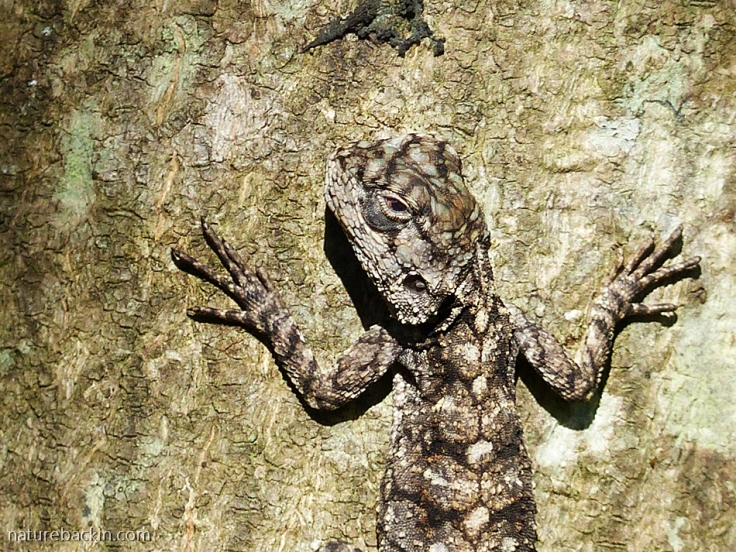
This young Southern Tree Agama is also soaking up some winter sunshine while camouflaged on the trunk of a tree
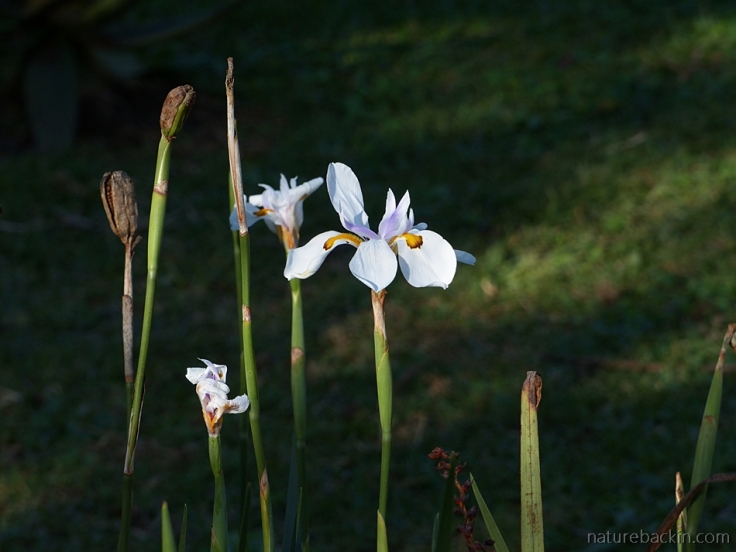
A Wild Iris (Dietes grandiflora), with some flowers having already gone to seed, illuminated by the rays of the late afternoon sun
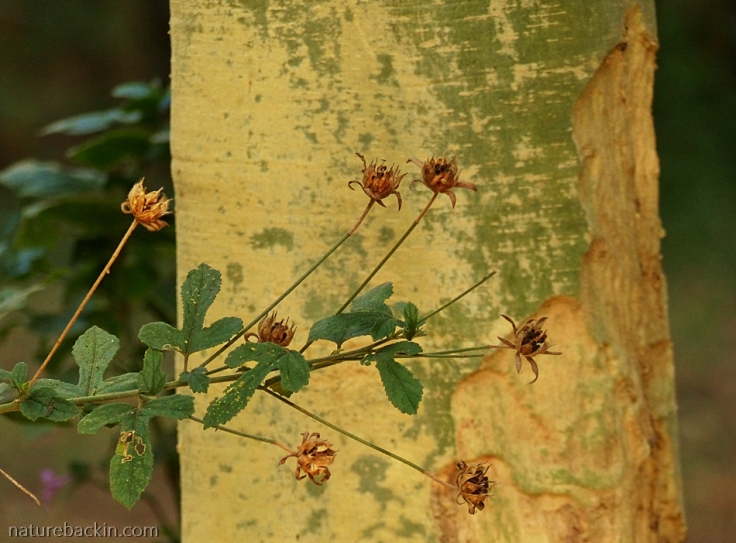
This last photo features seedheads of the Forest Pink Hibiscus (Hibiscus pedunculatus) with the yellow and green tones of the trunk of a Fever Tree (Vachellia xanthophloea formerly Acacia xanthophloea) as background. Golden-infused tones are very much the colours of our dry winter months
Posted by Carol

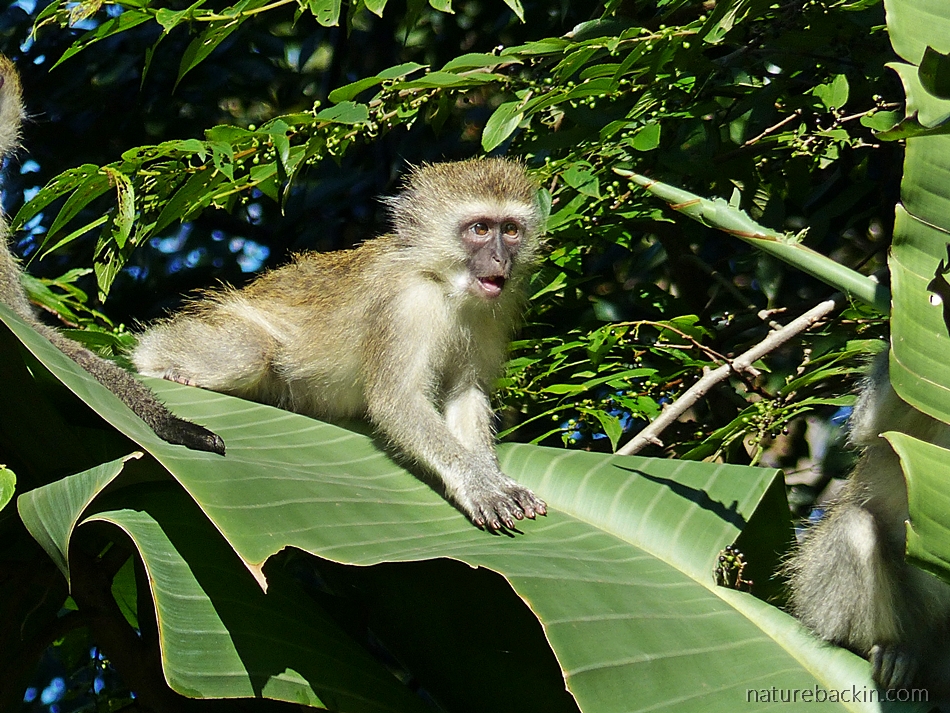







August 29, 2019 at 3:59 pm
that is a really good close up picture of the ant! I always find it hard to get pictures of them because they just don’t stop moving. Well done!
LikeLiked by 1 person
August 30, 2019 at 1:03 pm
Thanks. It helped that the ant was large and also quite slow 🙂
LikeLiked by 1 person
August 19, 2019 at 1:25 pm
Hi Aunty Carol
Yet another beautiful blog. Such a joy to look at all your lovely pics and the info is great.
Thank you 🌸🦋
LikeLiked by 1 person
August 22, 2019 at 6:08 pm
So much Debs. Love to you all.
LikeLike
August 14, 2019 at 12:31 pm
We just returned from the Isimangaliso Heritage Site, north of where you live. I am only catching up with your last posts now, but must comment, although somewhat late. What an interesting selection of photo’s! Thanks so much!
LikeLiked by 1 person
August 14, 2019 at 6:11 pm
Thank you Suzette. I hope you enjoyed your time at Isimangaliso.
LikeLike
July 31, 2019 at 6:13 pm
Your garden looks astonishlingy green and colourful for a winter garden!
LikeLiked by 1 person
July 31, 2019 at 6:14 pm
I mean astonishingly 🙂
LikeLiked by 1 person
August 1, 2019 at 9:23 pm
I think the typo served as an excellent emphasis 🙂 So much so I didn’t even notice it!
LikeLiked by 1 person
August 2, 2019 at 4:12 am
Haha. It is dry here too, but in Mozambique also much greener than say, the Highveld and Freestate where I have been recently.
LikeLiked by 1 person
August 1, 2019 at 9:22 pm
It is dry though, but last night we had a smattering of very welcome rain 🙂
LikeLike
July 29, 2019 at 2:12 am
What a lovely sample of delights. WordPress seems to be messing with me and lost a comment I just tried to post. I’ll try to recreate. I’m sure I mentioned that I think the Vervet monkey is really cute with that expressive face. I also liked that last image. It reminds me of a certain style that has a name, but I still am not able to recall what that might be. It’s the sort of thing that might be nice on wallpaper or a throw or even some tiles somewhere in a kitchen.
LikeLiked by 1 person
July 29, 2019 at 6:22 am
Thank you Gunta. It is so annoyang when comments get lost. Thank you for going to the trouble of redoing it! I am always glad when people respond positively to vervets. I know what you mean about the last image but I had no idea the style might have a name ☺
LikeLike
July 30, 2019 at 12:29 am
Not trouble at all, except that it always seems as though that first attempt was said just so exactly right and trying to recreate it seems to fall flat. 😉
LikeLiked by 1 person
July 31, 2019 at 10:33 am
I’ve had that feeling too when rewriting a lost comment 🙂
LikeLiked by 1 person
July 28, 2019 at 3:16 pm
Your photographs are spectacular, as is the wealth of information. You have a magical garden and eye
LikeLiked by 1 person
July 29, 2019 at 6:14 am
Thank you very much Mariss.
LikeLiked by 1 person
July 28, 2019 at 7:57 am
Your garden is a dream and vital for flora and fauna! In Germany it is also so hot and dry the second summer in succession, the nature is suffering so much! It breaks my heart to see all this falling leaves in July!
I love your diversity of pictures, but the honey bee seeking food at a Strelizia is overwhelming!!
LikeLiked by 1 person
July 29, 2019 at 6:18 am
Thank you Simone. Yes the high temperatures are worrying on so many levels in so many places. We are seeing mosquitoes about in winter, which I don’t remember ever having seen before.
LikeLiked by 1 person
July 29, 2019 at 11:00 am
Yes, global warming is now becoming increasingly visible. Wish you a nice week!
LikeLiked by 1 person
July 29, 2019 at 8:01 pm
Indeed it is. This is the first winter where I am not looking forward to our summer – in fact I am rather afraid looking ahead.
Despite all the worries, I hope you have a nice week too.
LikeLiked by 1 person
July 26, 2019 at 7:23 pm
It’s hard to see this as a winter scrapbook.It’s a delightful insight into the difference between your winters and ours. And we of course are over-egging summer at the moment, as you may have heard.
LikeLiked by 1 person
July 29, 2019 at 6:15 am
Yes had heard. Crazy temperatures in so many regions.
LikeLiked by 1 person
July 26, 2019 at 11:25 am
A smorsgabord! Lovely to see the range and variety in your garden, Carol. I especially like the kingfisher silhouette and the drongo in flight 🙂
LikeLiked by 1 person
July 26, 2019 at 2:21 pm
Thank you Sandra. Those two photos are a bit different so I am pleased to hear that you like them 🙂
LikeLiked by 1 person
July 26, 2019 at 7:49 am
I noticed a Hardeda strutting about with its wing at a strange angle the other day, thinking it may have damaged itself. So it was just doing what I was doing – looking for some sunshine warmth.
LikeLiked by 1 person
July 26, 2019 at 2:18 pm
All of us creatures similarly seek out the winter sunshine in the chilly mornings. Even though its quite hot at midday, the mornings can still have quite a chill to them.
LikeLike
July 26, 2019 at 5:56 am
There’s always something going on in your garden. Must be fun going out each day to see what’s happening. Great selection of photos as always.
LikeLiked by 2 people
July 26, 2019 at 2:17 pm
Thank you Graham. I do tend to go outside with a sense of expectation. There is always something to notice, even if its just the ongoing changes in flowers and leaves, or the clouds and the quality of the light.
LikeLiked by 2 people
July 26, 2019 at 4:35 am
A wonderful collection! So much life, great and small. I like the scrap metal birds too 🙂
LikeLiked by 1 person
July 26, 2019 at 2:15 pm
Thanks Adele. I am fond of the metal ducks too. Some of these metal constructions, often sold by crafters at the roadside, can be enormous – from near life-size herons to truly large kudu with horns. I prefer the smaller creations.
LikeLiked by 1 person
July 26, 2019 at 4:24 am
Thank you Carol! Your garden is a delight, thanks for sharing.
LikeLiked by 1 person
July 26, 2019 at 2:07 pm
Thank you very much, Carol. (I think you are also a Carol?) It is remarkable how so much copes in the dryness.
LikeLiked by 1 person
July 27, 2019 at 11:37 am
Yes another Carol!
LikeLiked by 1 person
July 29, 2019 at 6:23 am
☺
LikeLike
July 26, 2019 at 3:50 am
I agree with Dries – your garden is a fine example of what one can achieve when one lets nature back in! This variety of photographs make me feel ‘at home’ in your garden.
LikeLiked by 2 people
July 26, 2019 at 2:00 pm
Thank you Anne. It is lovely to share with someone who also likes to provide space to let nature back in as it does very nicely when given half a chance 🙂
LikeLike
July 26, 2019 at 2:32 pm
It certainly does!
LikeLiked by 1 person
July 26, 2019 at 3:50 am
Lovely selection Carol! xxxx
LikeLiked by 1 person
July 26, 2019 at 1:57 pm
Thank you Christeen. I hope that where you are is not quite as dry as it is here.
LikeLike
August 1, 2019 at 3:49 am
Bone dry, the well is way down. This morning is damp and misty for the first time this month, but no real rain. xxx
LikeLiked by 1 person
August 1, 2019 at 9:24 pm
The dryness is so worrying this hot winter. Where is the snow in the mountains? We also had dampness last night and even a light shower – very welcome, but very light.
LikeLiked by 1 person
July 26, 2019 at 2:28 am
Your garden certainly is a paradise, Carol, even in winter – and the number of species that find harbour there is a testament to that. I always look forward to a Friday morning to see what you’ve shared, and you’ve never disappointed.
LikeLiked by 2 people
July 26, 2019 at 1:56 pm
The garden is dry and scraggy round the edges, but the main thing is that it manages to makes is contribution to supporting quite a bit of life even in these dry times.
I am glad/relieved that you liked this post as on Wednesday I was still wondering what on earth I was going to post about! Usually something bites a bit sooner than that.
LikeLiked by 2 people
July 25, 2019 at 9:49 pm
Hi Carol, What a treat to find your blog. Your nature photos are exquisite– so well seen and composed. Enjoyed every one. Terrific work.
LikeLiked by 1 person
July 26, 2019 at 1:52 pm
Hi Jane. Thank you very much for your kind comment 🙂
LikeLiked by 1 person
July 25, 2019 at 9:21 pm
A nice post – I like wandering through your garden. 🙂
LikeLiked by 1 person
July 26, 2019 at 1:50 pm
Thanks Eliza – it is robust rather than pretty and does not provide for the vase as beautifully as your lovely summer garden does 🙂
LikeLiked by 1 person
July 25, 2019 at 9:19 pm
What a nice round up of pics! Gosh, mushrooms always look like they’re from another planet. So neat looking 🙂
LikeLiked by 1 person
July 26, 2019 at 1:49 pm
Thanks M.B. You have given me a new perspective on mushrooms 🙂
LikeLiked by 1 person
July 26, 2019 at 8:41 pm
Well I’m always glad when I can help 🙂
LikeLiked by 1 person
July 29, 2019 at 6:16 am
😊
LikeLike